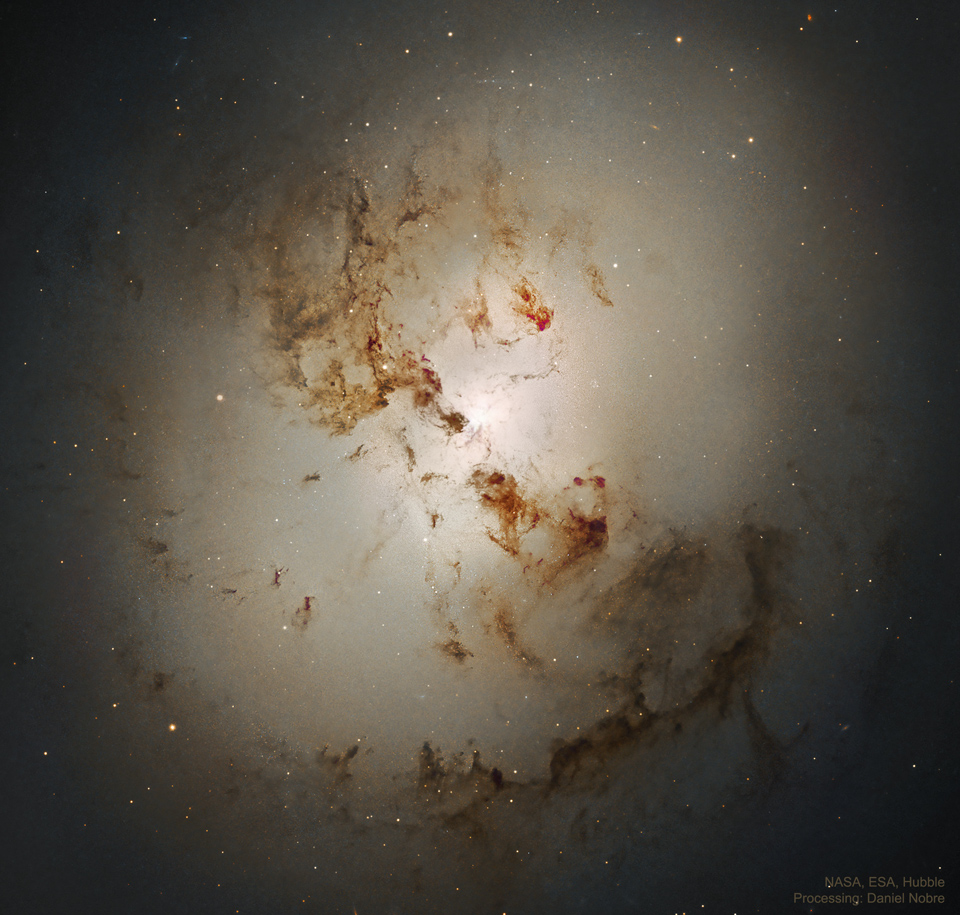26. January 2021
NGC 1316 ê 中央:星系相碰了後

探索宇宙1!逐工會揀一幅無仝款 ê 影像抑是相片,𤆬你熟似咱這个迷人 ê 宇宙,閣有專業天文學者2為你解說3。
- 原始文章:Central NGC 1316: After Galaxies Collide
- 影像來源:NASA, ESA, Hubble
- 影像處理佮版權:Daniel Nobre
- 台文翻譯:An-Li Tsai (NCU)
[漢羅] NGC 1316 ê 中央:星系相碰了後
這个看起來遮爾奇怪 ê 星系,是按怎產生 ê?為著欲揣出像 NGC 1316 這款,內底 ê 恆星、氣體、塗粉 lóng 四界亂掖 ê 情形 sī 按怎發生 ê?天文學者 soah-lâi 變做偵探。檢查了後認為,NGC 1316 是一个足大 ê 長株圓星系。毋閣,毋知是按怎,伊嘛有 tī 捲螺仔星系 內底才有 ê 塗粉烏帶。用 哈伯太空望遠鏡 翕 ê 影像 to̍h 看會著詳細情形。這會當 kā 這个遮爾 大型 ê 交纏 歷史,重新交代清楚。Tī 這幅深空 koh 闊幅 ê 影像,看會著 相碰產生 ê 巨殼。毋閣,siāng 中央 ê 影像看會著 NGC 1316 內部幾个仔 球形星團。有這款現象,to̍h 表示 tī 過去這幾十億年來,這个星系猶閣 kah 其他 ê 星系 繼續 leh 相碰 ia̍h-sī 合併。Tī 這張影相 ū 足明顯 ê 塗粉 烏瘤 kah 塗粉烏帶。這代表遮 siāng-bô 有一个捲螺仔星系去予食去矣。NGC 1316 to̍h 佇 天爐座 ê 方向,有 5 萬光年闊,離咱有 6 千萬 光年 遠。
[POJ] NGC it-sam-it-lio̍k ê tiong-ng: seng-hē sio-pōng liáu-āu
Chit-ê khòaⁿ–khí-lâi chiah-nī kî-koài ê seng-hē, sī án-ná sán-seng ê? Ūi-tio̍h beh chhōe-chhut chhiūⁿ NGC it-sam-it-lio̍k chit-khoán, lāi-té ê hêng-chhiⁿ, khì-thé, thô͘-hún lóng sì-kè-loān-iā ê chêng-hêng sī án-ná hoat-seng ê? Thian-bûn ha̍k-chiá soah-lâi piàn-chò cheng-thàm. Kiám-cha liáu-āu jīn-ûi, NGC it-sam it-lio̍k sī chi̍t-ê chiok tōa ê tn̂g-tu-îⁿ seng-hē. M̄-koh, m̄-chai sī án-nóa, i mā ū tī kńg-lê-á seng-hē lāi-té chiah ū ê thô͘-hún o͘-tòa. Iōng Ha-peh thài-khong-bōng-oán-kiàⁿ hip-ê iáⁿ-siōng to̍h khòaⁿ-ē-tio̍h siông-sè chêng-hêng. Che ē-tàng kā chit-ê chiah-nī tōa-hêng ê kau-tîⁿ le̍k-sú, tiông-sin kau-tài chheng-chhó͘. Tī chit-pak chhim-khong koh khoah-pak ê iáⁿ-siōng, khòaⁿ-ē-tio̍h sio-pōng sán-seng ê kū-khak. M̄-koh, siāng tiong-ng ê iáⁿ-siōng khòaⁿ-ē-tio̍h NGC it-sam-it-lio̍k lōe-pō͘ kúi-ê-á kiû-hêng seng-thoân. Ū chit-khoán hiān-siōng, to̍h piáu-sī tī kòe-khì che kúi-cha̍p-ek nî lâi, chit-ê seng-hē iáu-koh kah kî-tha ê seng-hē kè-sio̍k leh sio-pōng ia̍h-sī ha̍p-pèng. Tī chit-tiuⁿ iáⁿ-siōng ū chiok bêng-hián ê thô͘-hún o͘-liû kah thô͘-hún o͘-tòa. Che tāi-piáu chia siāng-bô ū chi̍t-ê kńg-lê-á seng-hē khì hō͘ chia̍h–khì-ah. NGC it-sam-it-lio̍k tī Thian-lô͘-chō ê hong-hiòng, ū gō͘-bān kng-nî khoah, lî lán ū la̍k-chheng-bān kng-nî hn̄g.
[KIP] NGC it-sam-it-lio̍k ê tiong-ng: sing-hē sio-pōng liáu-āu
Tsit-ê khuànn-khí-lâi tsiah-nī kî-kuài ê sing-hē, sī án-ná sán-sing ê? Uī-tio̍h beh tshuē-tshut tshiūnn NGC it-sam-it-lio̍k tsit-khuán, lāi-té ê hîng-tshinn, khì-thé, thôo-hún lóng sì-kè-luān-iā ê tsîng-hîng sī án-ná huat-sing ê? Thian-bûn ha̍k-tsiá suah-lâi piàn-tsò tsing-thàm. Kiám-tsa liáu-āu jīn-uî, NGC it-sam it-lio̍k sī tsi̍t-ê tsiok tuā ê tn̂g-tu-înn sing-hē. M̄-koh, m̄-tsai sī án-nuá, i mā ū tī kńg-lê-á sing-hē lāi-té tsiah ū ê thôo-hún oo-tuà. Iōng Ha-peh thài-khong-bōng-uán-kiànn hip-ê iánn-siōng to̍h khuànn-ē-tio̍h siông-sè tsîng-hîng. Tse ē-tàng kā tsit-ê tsiah-nī tuā-hîng ê kau-tînn li̍k-sú, tiông-sin kau-tài tshing-tshóo. Tī tsit-pak tshim-khong koh khuah-pak ê iánn-siōng, khuànn-ē-tio̍h sio-pōng sán-sing ê kū-khak. M̄-koh, siāng tiong-ng ê iánn-siōng khuànn-ē-tio̍h NGC it-sam-it-lio̍k luē-pōo kuí-ê-á kiû-hîng sing-thuân. Ū tsit-khuán hiān-siōng, to̍h piáu-sī tī kuè-khì tse kuí-tsa̍p-ik nî lâi, tsit-ê sing-hē iáu-koh kah kî-tha ê sing-hē kè-sio̍k leh sio-pōng ia̍h-sī ha̍p-pìng. Tī tsit-tiunn iánn-siōng ū tsiok bîng-hián ê thôo-hún oo-liû kah thôo-hún oo-tuà. Tse tāi-piáu tsia siāng-bô ū tsi̍t-ê kńg-lê-á sing-hē khì hōo tsia̍h–khì-ah. NGC it-sam-it-lio̍k tī Thian-lôo-tsō ê hong-hiòng, ū gōo-bān kng-nî khuah, lî lán ū la̍k-tshing-bān kng-nî hn̄g.
[English] Central NGC 1316: After Galaxies Collide
How did this strange-looking galaxy form? Astronomers turn detectives when trying to figure out the cause of unusual jumbles of stars, gas, and dust like NGC 1316.Inspection indicates that NGC 1316 is an enormous elliptical galaxy that somehow includes dark dust lanes usually found in a spiral galaxy . Detailed images taken by the Hubble Space Telescope shows details, however, that help in reconstructing the history of this gigantic tangle . Deep and wide images show huge collisional shells , while deep central images reveal fewer globular clusters of stars toward NGC 1316’s interior. Such effects are expected in galaxies that have undergone collisions or merging with other galaxies in the past few billion years. The dark knots and lanes of dust , prominent in the featured image , indicate that one or more of the devoured galaxies were spiral galaxies. NGC 1316 spans about 50,000 light years and lies about 60 million light years away toward the constellation of the Furnace ( Fornax ).
詞彙學習(漢羅/POJ/KIP/華語/English)
- 【偵探】cheng-thàm/tsing-thàm/偵探/detective
- 【長株圓星系】tn̂g-tu-îⁿ seng-hē/tn̂g-tu-înn sing-hē/橢圓星系/elliptical galaxy
- 【捲螺仔星系】kńg-lê-á seng-hē/kńg-lê-á sing-hē/螺旋星系/spiral galaxy
- 【塗粉烏帶】thô͘-hún o͘-tòa/thôo-hún oo-tuà/暗灰塵帶/dark dust lane
- 【哈伯太空望遠鏡】Ha-peh thài-khong-bōng-oán-kiàⁿ/Ha-peh thài-khong-bōng-uán-kiànn/哈伯太空望遠鏡/Hubble Space Telescope
- 【球形星團】kiû-hêng seng-thoân/kiû-hîng sing-thuân/球狀星團/globular clusters of stars
- 【塗粉烏瘤】thô͘-hún o͘-liû/thôo-hún oo-liû/暗灰塵結/dark dust knot
- 【天爐座】Thian-lô͘-chō/Thian-lôo-tsō/天爐座/the constellation of the Furnace (Fornax)